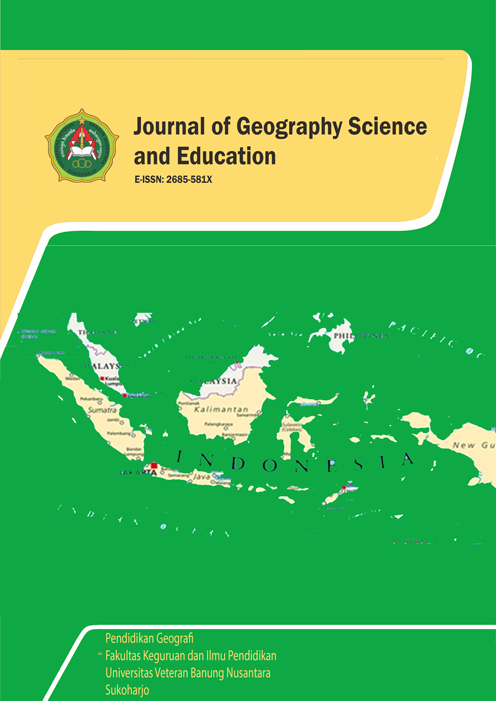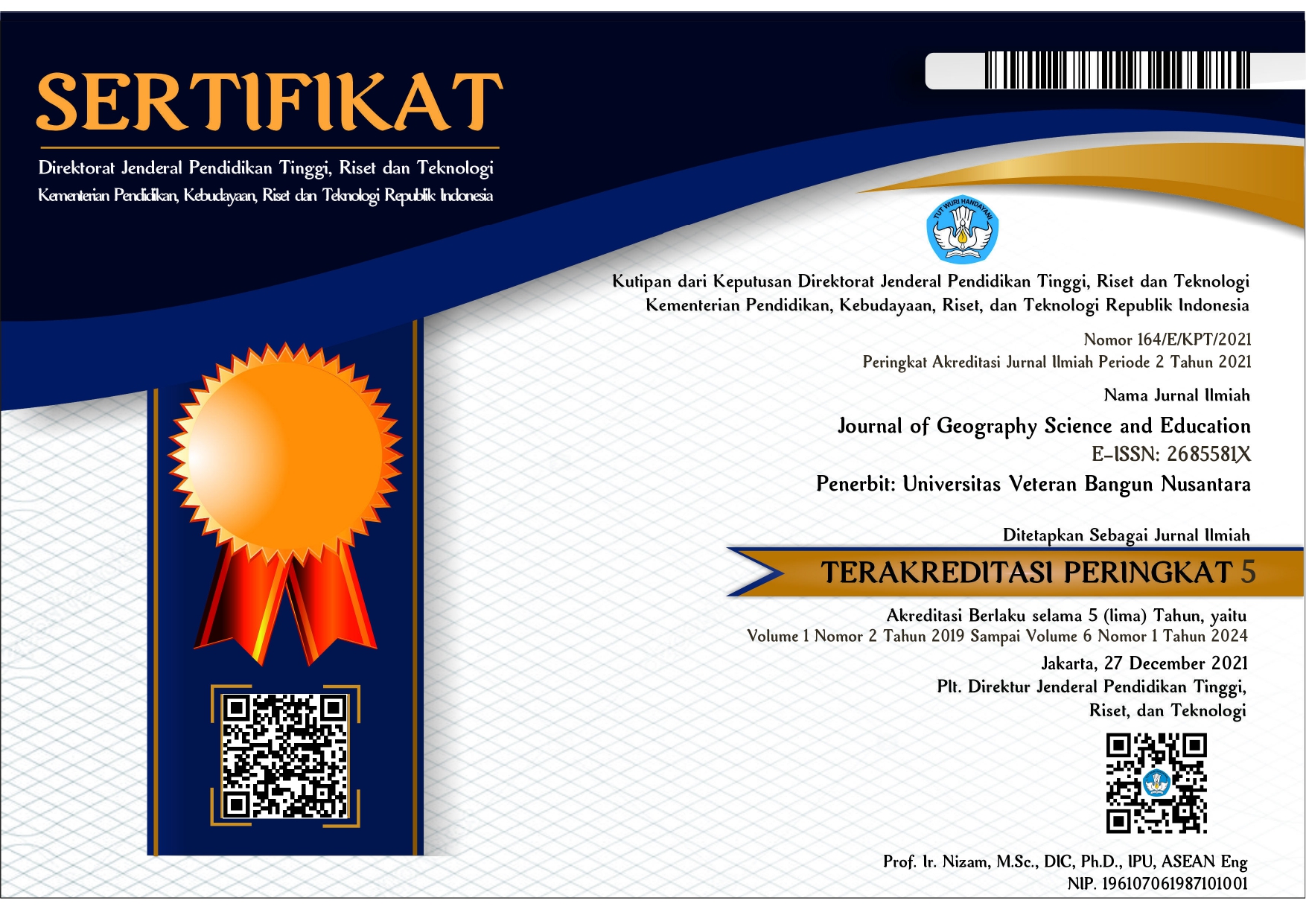The Effect of Using Canva-Based Media Usage on Geography Learning Outcomes of Class X Students at UNPATTI Laboratory High School
DOI:
https://doi.org/10.32585/jgse.v6i1.5766Abstrak
This study aims to determine the effect of using Canva digital media on the geography learning outcomes of tenth-grade students on the lithosphere material at UNPATTI Laboratory High School. This research employs an experimental method with a control group and an experimental group design. The research sample consists of 28 students divided into two groups: the control group, which used conventional learning methods, and the experimental group, which used Canva. The results of the independent t-test shown in the table indicate a significant difference between the learning outcomes of the control group and the experimental group. The Levene's Test showed an F value of 0.804 with a significance value (Sig.) of 0.378, indicating that the assumption of equal variances is acceptable. In the t-test for mean comparison, the obtained t value was -2.651 with degrees of freedom (df) of 26 for the assumption of equal variances, and 25.547 for the assumption of unequal variances. The two-sided significance value, which was less than 0.05 (0.013 and 0.014 respectively), indicates a significant difference between the two groups. The mean difference between the two groups was -5.857, showing that the learning outcomes of the control group were significantly lower than those of the experimental group. The results of the independent t-test showed a significant difference between the learning outcomes of the two groups, with the experimental group showing higher learning outcomes. These findings suggest that using Canva as a learning tool can enhance learning outcomes for tenth-grade students on lithosphere material. This study supports the literature stating that interactive technology-based learning approaches can positively impact learning outcomes. Therefore, the use of Canva in learning can be considered an effective strategy to improve educational quality.
Unduhan
Unduhan
Diterbitkan
Cara Mengutip
Terbitan
Bagian
Lisensi
Hak Cipta (c) 2024 Dwi Partini, Asrul

Artikel ini berlisensiCreative Commons Attribution-ShareAlike 4.0 International License.
License and Copyright Agreement
In submitting the manuscript to the journal, the authors certify that:
- They are authorized by their co-authors to enter into these arrangements.
- The work described has not been formally published before, except in the form of an abstract or as part of a published lecture, review, thesis, or overlay journal. Please also carefully read JGSE's Posting Your Article Policy at http://pubs2.ascee.org/index.php/ijele/about/editorialPolicies#custom-5
- That it is not under consideration for publication elsewhere,
- That its publication has been approved by all the author(s) and by the responsible authorities – tacitly or explicitly – of the institutes where the work has been carried out.
- They secure the right to reproduce any material that has already been published or copyrighted elsewhere.
- They agree to the following license and copyright agreement.
Copyright
Authors who publish with Journal of Geography Science and Education agree to the following terms:
- Authors retain copyright and grant the journal right of first publication with the work simultaneously licensed under a Creative Commons Attribution License (CC BY-SA 4.0) that allows others to share the work with an acknowledgment of the work's authorship and initial publication in this journal.
- Authors are able to enter into separate, additional contractual arrangements for the non-exclusive distribution of the journal's published version of the work (e.g., post it to an institutional repository or publish it in a book), with an acknowledgment of its initial publication in this journal.
- Authors are permitted and encouraged to post their work online (e.g., in institutional repositories or on their website) prior to and during the submission process, as it can lead to productive exchanges, as well as earlier and greater citation of published work.
Licensing for Data Publication
Journal of Geography Science and Education use a variety of waivers and licenses, that are specifically designed for and appropriate for the treatment of data:
- Open Data Commons Attribution License, http://www.opendatacommons.org/licenses/by/1.0/ (default)
- Creative Commons CC-Zero Waiver, http://creativecommons.org/publicdomain/zero/1.0/
- Open Data Commons Public Domain Dedication and Licence, http://www.opendatacommons.org/licenses/pddl/1-0/
Other data publishing licenses may be allowed as exceptions (subject to approval by the editor on a case-by-case basis) and should be justified with a written statement from the author, which will be published with the article.
Open Data and Software Publishing and Sharing
The journal strives to maximize the replicability of the research published in it. Authors are thus required to share all data, code or protocols underlying the research reported in their articles. Exceptions are permitted but have to be justified in a written public statement accompanying the article.
The associated persistent identifiers (e.g. DOI, or others) of the dataset(s) must be included in the data or software resources section of the article. Reference(s) to datasets and software should also be included in the reference list of the article with DOIs (where available). Where no domain-specific data repository exists, authors should deposit their datasets in a general repository such as ZENODO, Dryad, Dataverse, or others.
Small data may also be published as data files or packages supplementary to a research article, however, the authors should prefer in all cases a deposition in data repositories.










